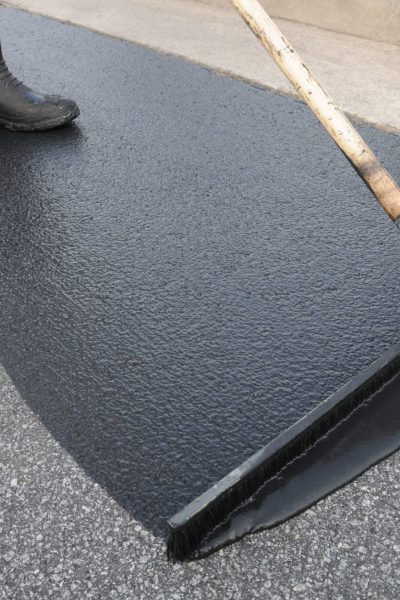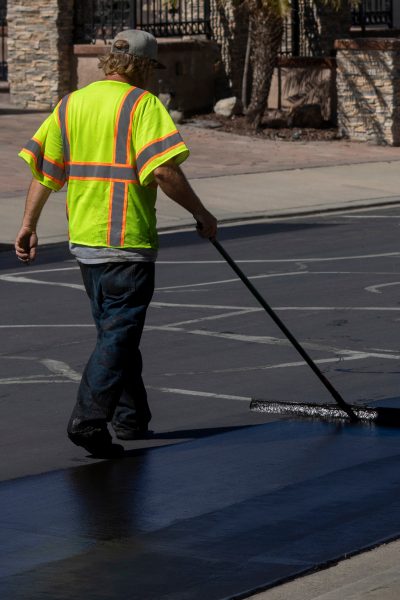Minnesota Commercial Asphalt Sealcoating and Maintenance
The best way to maintain your investment is to protect it with regular maintenance, especially crack sealing and sealcoating.
These maintenance services will extend the life of your asphalt and reduce the overall cost of ownership.
The key to maintaining your asphalt pavement is preventative maintenance. There are three primary maintenance “musts”, which will extend the life of your asphalt. These maintenance efforts include patching any problem areas, sealing all cracks and sealcoating when the time is right.
Asphalt sealcoating is a protective treatment applied to asphalt surfaces to extend their lifespan and enhance their appearance. It involves spreading a layer of sealant over the surface, which helps to protect against weather elements like UV rays, rain, and snow, as well as prevent damage from oils, gasoline, and other chemicals. Sealcoating also fills in minor cracks and creates a smooth, uniform surface. By reducing oxidation and water penetration, it can prevent the underlying asphalt from breaking down and becoming brittle, ultimately saving on costly repairs and resurfacing in the future. Regular sealcoating helps maintain the durability and aesthetic quality of driveways, parking lots, and roads. We strongly recommend sealing all cracks and patching where needed prior to sealcoating.
As mentioned, asphalt crack filling is a vital service designed to prevent damage to asphalt surfaces by sealing cracks and gaps before they expand. We encourage all customers to include crack sealing as an added service while sealcoating. During the process, high-quality crack filler materials are injected into the cracks, ensuring a strong bond that prevents water, dirt, and debris from infiltrating the surface. This helps to reduce the risk of erosion and deterioration caused by moisture, which can lead to more extensive damage like potholes. Crack filling is an affordable and effective solution to maintain the structural integrity of asphalt driveways, parking lots, and roadways, ultimately prolonging the life of the pavement and reducing the need for costly repairs or replacements.
Asphalt patching is the last of the three primary asphalt maintenance services. This process involves cleaning out the damaged section(s) of asphalt, removing any debris, and filling the void with fresh, high-quality asphalt mix. The patch is then compacted to ensure a smooth, durable surface that seamlessly blends with the surrounding pavement. Asphalt patching is a cost-effective solution to restore the functionality and appearance of driveways, parking lots, and roads, preventing further damage from water infiltration or traffic stress. It helps maintain safety and aesthetics while extending the lifespan of the pavement.
Sealcoating FAQs
How often does asphalt require sealcoating?
Sealcoating is typically recommended every 1-3 years, depending on the level of traffic, climate, and the condition of the asphalt. If your asphalt is showing signs of wear, such as fading or cracking, it may be necessary to sealcoat more frequently.
How long does it take for sealcoating to dry?
The drying time for sealcoating varies based on the weather conditions, but typically, it takes 24-48 hours for the sealcoat to dry enough for light traffic. Full curing can take up to 72 hours, depending on temperature and humidity.
Patching and Crack Sealing FAQs
Why is asphalt patching necessary?
Patching is necessary to prevent further damage, reduce safety hazards, improve the aesthetics of the surface, and extend the lifespan of the asphalt. Potholes and cracks, if left untreated, can worsen, causing more expensive repairs later.
How long does asphalt patching last?
The lifespan of a patch depends on several factors, including the type of patch used, weather conditions, traffic load, and how well the patch was applied. Hot mix patches can last anywhere from 5-15 years, while cold patches are generally less durable.
How can I prevent the need for asphalt patching in the future?
Regular maintenance, such as sealing cracks, resealing the surface, and addressing drainage issues, can help prevent further damage. Proper weight limits and timely repairs also help protect the surface.
What is asphalt crack sealing?
Crack filling is the process of filling cracks in asphalt surfaces with a specialized material to prevent water infiltration and further damage. This is typically done to address minor cracks before they become larger, more expensive issues like potholes or extensive pavement deterioration.
How often do you need to seal asphalt cracks?
Crack filling should be done as soon as cracks begin to appear. Small cracks should be filled immediately, as this can prevent them from expanding into larger, more costly repairs. Typically, crack filling is done every 1-2 years depending on traffic and environmental conditions.


